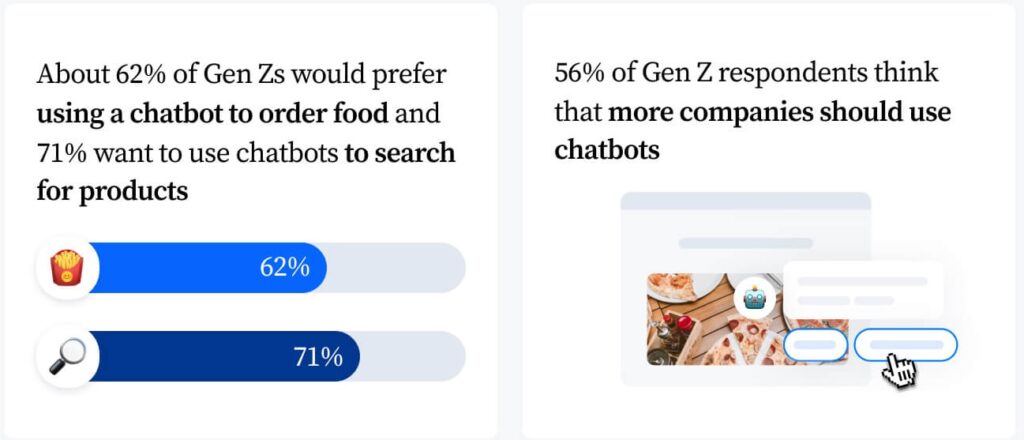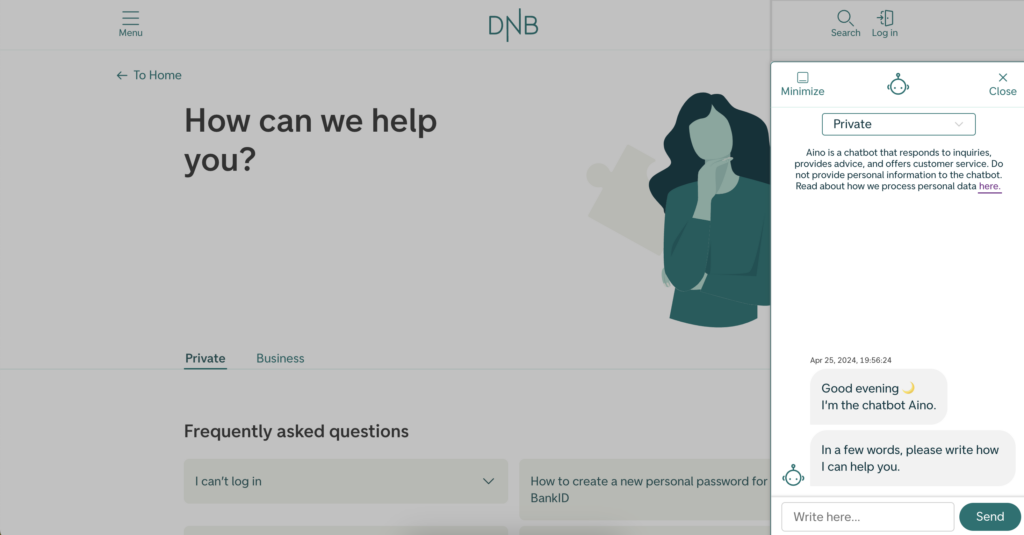
AI-Driven Chatbots in Customer Support: Interactive Service for Business Growth
The level of modern technological progress, advanced AI capabilities, instant messaging, and the fast pace of life have had a significant effect on how consumers behave and what level of customer experience they expect. One of the aspects that were affected the most is the way brands interact with customers. Consumers don’t want a passive one-sided communication approach from businesses, their expectations are at a brand-new level. Therefore, marketing agencies such as Multiplayer develop new interactive solutions to establish better communication with customers. What customers expect is a fast, efficient, and personalized way to interact with a brand, especially when it comes to resolving their problems.
Such traditional methods of communication as email ticketing and phone calls do not provide users with the desired level of customer support, especially when they need an urgent reply and/or help. This is where AI can demonstrate its full power in the form of AI-powered chatbots that are emerging as a game-changer, offering businesses endless benefits.
AI chatbots’ main feature is that they use natural language processing and machine learning to provide features like 24/7 availability, instant responses, personalized interactions, and self-service options. From enhancing product recommendations in e-commerce to streamlining account management in banking, AI chatbots are delivering significant improvements in customer satisfaction, operational efficiency, and cost savings. Looking ahead, advancements in AI technology promise even more sophisticated chatbots with superior natural language understanding and problem-solving abilities.
The Customer Service in the Age of AI: Redefining Expectations and Transforming the Approach
Customer service is undergoing a significant transformation, mostly because today’s consumers demand a level of service that surpasses the limitations of traditional methods. Customers expect immediate, personalized, and efficient interactions across all channels. And the key factors behind this transformation are the following:
The Rise of the Digital Customer
Everybody could already notice the significant changes that have taken place in customers behavior and the way we interact with businesses. For the past several years a new medium between businesses and customers has been playing a significant role. This medium is technology. Customers are becoming increasingly tech-savvy: they know how to conduct research online, they compare products and services before making a decision and make purchases with a click. And, since brands provide customers with easy-to-access purchase ways, customers in return expect no less quality and accessibility from customer support. This digital fluency has transformed into higher expectations for customer service channels and overall online experience.
The Power of Social Media
Social media platforms have become a powerful tool for customer feedback, both positive and negative. A single bad review left on social media can quickly go viral and damage a brand’s reputation for a very long time. Customers expect professional and ‘to-the-point’ responses that will allow them to solve problems immediately. Therefore, making real-time engagement is a critical aspect of modern customer service.
The On-Demand Economy
The rise of services like Uber, Netflix, and DoorDash, where customers get what they need right away, has made customers expect quick and easy service from businesses. As for the customer service, they want information, answers, and solutions at their fingertips 24/7. Thus, traditional customer support models that rely on fixed operating hours or limited agent availability simply aren’t providing customers with the service standards that they need.
The Importance of Experience
Customer experience (CX) has become a key component for the business that makes them stand out from competitors. Studies show that companies that excel in customer experience outperform their competitors by as much as 80%. Therefore, companies that don’t pay much attention to the customer service quality and functionality may be at the risk of being left behind.
The Limitations of Traditional Customer Support Methods
Before introducing the advantages of AI-powered chatbots, let’s discuss why traditional means of customer support are not so effective anymore and why introduction of AI technologies is even necessary. In general, traditional customer support methodologies are struggling to keep pace with modern customers’ expectations.
Here’s a closer look at some of the shortcomings:
- Phone Queues and Wait Times: Reaching a live agent via phone can be a frustrating experience. Customers often face long wait times, and navigating complex IVR systems can be a barrier to getting the help they need. This can lead to customer dissatisfaction and abandonment, especially if a customer is contacting support for some easy-to-solve issue. According to the research, about 53% of respondents find waiting too long for replies the most frustrating part of interacting with businesses. Imagine waiting for an hour in a queue to get a reply from an operator just to solve an issue in 5 minutes. Such situations can cause anger and frustration despite the fact that the problem was actually solved.
- Email Ticketing Systems: While email offers an asynchronous alternative to phone calls, it can be slow and inefficient. Resolutions can take days or even weeks, especially with complex issues. Additionally, email communication lacks the real-time interaction and human touch that some customers value. Additionally to long waiting times, a customer very often has no chance to see the status of an email: has it been read? or even delivered? Therefore, email ticketing systems are not reliable when it comes to cases when a solution is urgently expected.
- Limited Agent Availability: Even though nothing can substitute a real human interaction, customer support that relies solely on agents replying to customers has serious drawbacks. First, traditional customer support teams typically operate during business hours, leaving customers with limited options outside those times. This can be particularly inconvenient for customers in different time zones or those with busy schedules. Secondly, it is impossible to expect from a customer support agent a high level of knowledge on every aspect of company operations. While customers can receive an immediate response regarding a standard or frequently asked questions, they can face much longer waiting times or a switch between multiple operators when it comes to a more specific problem or situation.
- Inconsistency in Service Quality: A human factor is something that cannot be overlooked if a company tries to provide customers with high quality service. Its quality can vary significantly depending on the agent a customer interacts with. A customer service worker can have training gaps, high call volumes or simply be distracted by personal issues which can lead to inconsistent information and frustrating interactions for customers.
- Limited Scalability: Traditional methods are often difficult and costly to scale to meet peak demands. During busy periods, wait times can increase, and customer satisfaction can plummet. According to the Live Chat Benchmark Report, the number of chats per agent grew by 138% in 2022 for teams with 26+ agents. It indicates that the number of customers who demand personal communication is growing and while using traditional methods it can be challenging to keep up with this pace.
The Inevitable Rise of AI in Customer Service
The need for innovative solutions for customer service is not just a trend caused by artificial intelligence advancement, it is a necessity that has developed from the limitations of traditional customer service. However, with the developments in natural language processing (NLP) and machine learning (ML) these needs can finally be met. It can be done with the help of AI-powered chatbots that can address many drawbacks of traditional methods of customer service:
- 24/7 Availability: AI chatbots are available 24/7, 365 days a year. AI-powered customer support doesn’t have holidays, sick leaves or simply bad moods. This allows customers to get answers to their questions or troubleshoot issues whenever it’s convenient for them, regardless of time zone or business hours.
- Faster Response Times: Unlike emails or phone calls, AI chatbots can provide immediate responses to basic questions, which has a positive effect overall on customer satisfaction. According to the data provided by Business2Community, 82% of consumers rate an “immediate” response as very important when they have a question.
- Personalized Interactions: AI chatbots can be programmed to personalize interactions based on a customer’s past interactions with a chatbot, purchase history, and other relevant data. AI-powered agents can ‘remember’ all the details of conversation with a customer and then provide a more detailed and targeted response. This allows for a more relevant and engaging customer experience. Moreover, the response received from an AI-assistant is not only informative, but can also be adapted to a tone and requirements of a customer. Natural language processing (NLP), which is also called by some a ‘superpower of chatbots’, can help computers not only understand a conversation with a customer word by word, but also interpret and generate human language in a personal way. This allows developing a more personalized conversation with a customer and provides high-quality service.
- Multilingual Support: Artificial intelligence also removes one of the most serious obstacles, language barrier. For local companies it may not be an issue due to the common language among customers and customer service agents. However, when it comes to an international company, making sure all customers regardless of their language are provided with the same level of service and not making any customer feel left out becomes a serious challenge. That is why AI-powered chatbots are the best solution for such cases. They can provide help to customers from any region or country and speak with them in their language without customers even noticing that they are talking with artificial intelligence.
- Self-Service Options: AI chatbots can be integrated with knowledge bases and FAQs, allowing customers to find answers to common questions without requiring human intervention. This empowers customers and reduces the burden on customer support teams. Moreover, particular groups of customers can especially benefit from the support of AI-powered agents. According to the data from the research, Gen Z believes that different situations require different ways of communicating with businesses. For example, 62% of Gen Zs would prefer using chatbots to order food and 71% would use chatbots to search for products.

The benefits of using AI-powered chatbots compared to traditional methods of communicating with customers are evident. The AI technologies have just started to demonstrate their power and more advantages of AI will appear along with the technological advancements.
How AI chatbots are boosting business across industries
A move towards AI by KIA
Kia launched a chatbot named Kian, an artificial intelligence-based virtual assistant meant to offer customers an improved online shopping experience. With the help of Kian, Kia has seen significant success, boasting a conversion rate of 21% compared to 7% on their website, which indicates that the chatbot was used 3 times more than their website.
Customers were highly engaged with Kian, exchanging over 600,000 messages and resulting in 50 times more engagement than Kia’s website. Nathalie Choy, national manager of digital, social and CRM marketing at Kia Motors America attributes this success to Kian’s ability to act as a one-stop shop for customer inquiries.
Unlike a traditional website, Kian uses conversation with customers and their inquiries to understand customer needs. Choy explains that website analytics don’t reveal a customer’s intent, whereas Kian can directly answer questions about lost keys, noisy brakes, or roadside assistance. Kian even integrates search functionality to compare Kia models and competitors.

Kia utilizes machine learning to analyze Kian interactions. This allows them to identify customer segments with similar interests. For example, Kia can target customers who inquired about the Kia Stinger with special offers. This targeted approach boasts a 24% response rate, highlighting the effectiveness of personalized communication.
Finally, Kia benefits from cost savings with Kian. The chatbot provides 24/7 customer support without requiring expensive investments in call centers or expanded support teams.
DNB Bank Achieves Success with AI-powered Chatbot Aino
DNB, the largest bank in Scandinavia by market value, faced the challenge of a high volume of messages in customer support. In order to tackle this workload they decided to try new technologies, artificial intelligence, instead of hiring more agents and applying traditional ways of communication with customers.
They have created an AI customer support agent called Aino that automates a substantial portion of customer service inquiries, freeing up human agents to handle more complex issues.
DNB implemented Aino as their first line of customer support, and within just six months, the chatbot was handling over 50% of all incoming chat traffic. Today, Aino automates between 50-60% of all incoming chat traffic and 22% of the bank’s total customer service traffic across all channels. This has led to a surge in customer satisfaction, with CSAT scores reaching record highs. “The results are a lot higher than we expected in such a short time,” says Brekke, EVP & Head of Digital Innovation at DNB, adding that the bank “works hard every day to make Aino even better and to find the right balance.”

Aino’s Capabilities
Aino is equipped to answer a wide range of customer questions and perform tasks related to accounts, credit cards, and loans. Logged-in users can even directly interact with their accounts through the chat interface. This extends Aino’s abilities beyond simple FAQs.
It automates thousands of questions daily, seamlessly transferring complex interactions to human agents when needed. This ensures a holistic customer experience where customers receive the help they need, whether from a human or a machine.
DNB’s chatbot strategy has also benefited its staff. Aino has significantly reduced the time spent on repetitive questions, allowing human agents to focus on more valuable interactions. Additionally, DNB has launched internal virtual agents powered to assist employees with HR and legal issues. The most notable is Juno, an advisory bot with over 5,000 daily users, designed to improve employee productivity by making information retrieval easier.
The Future of DNB’s AI Strategy
DNB plans to further develop its AI chatbot capabilities. They aim to expand the variety of tasks Aino and other chatbots can handle and personalize the chat experience for each customer. The bank also plans to grow its AI Trainer team, which focuses on optimizing chatbot responses for both customers and employees.
A Model for the Industry
DNB’s success with Aino serves as a model for the financial industry. AI chatbots are rapidly growing in popularity within the banking sector, and they are expected to be a key tool for banks worldwide. These AI-powered solutions provide a cost-effective way for banks to communicate with customers and offer a more convenient and secure way for customers to access banking services.
North Face Scores Big in retail with AI-powered Shopping Assistant
AI is trending in retail, and chatbots are a particularly tempting option for brands. One such chatbot is helping outerwear giant North Face revolutionize the online shopping experience for jackets.
Launched in late 2015, North Face’s virtual shopping assistant uses a question-and-answer format to guide customers to their perfect jacket. After just two months, results were impressive: a high satisfaction rate and a 75% sales conversion rate.

How it Works: A Conversation, Not a Catalog Browse
Customers can forget about endless scrolling. The North Face’s AI assistant can help customers what they need by asking questions and helping them find the desired product. Imagine shopping for a winter jacket online. Forget endless scrolling, you can chat with North Face’s AI assistant. For example, if a customer wants to buy a winter jacket online they just need to ask an AI-assistant to help find it. They can write where and when they will be using a jacket, “hiking in Iceland in November” and then the assistant gives results after a series of questions and answers. The assistant refines options with follow-up questions, ultimately to “the perfect jacket for your adventure.”
Learning from Every Interaction
AI-assistant uses machine learning to get smarter with each interaction. By analyzing which recommended jackets end up in shopping carts, it personalizes future recommendations, potentially leading to even higher conversions.
Cal Bouchard, North Face’s Senior Director for eCommerce, is confident this is a game-changer. The brand is taking things a step further with a mobile app featuring voice-enabled interactions. This voice element adds a personal touch, making the shopping experience even more convenient.
Tourism industry takes one step further with AI chatbots
Travel chatbots have already become irreplaceable assistants in the tourism industry. According to the studies, 33% of travelers prefer using AI-powered chatbots for reservations while 67% find them helpful for managing trips. This demand for time-saving and cost-effective assistants is understandable since it saves time for customers and presents a cost-saving tool for businesses.
Edward: A Case Study in AI-powered Hotel Management
One example of a successful travel chatbot is Edward, created by a hotel chain, Edwardian Hotels. Edward began as a mobile app for housekeepers, offering real-time information on room cleaning queues and guest preferences. This AI system even learned guest behaviors, allowing housekeepers to personalize service through thoughtful touches.
Edward’s success led to the development of mobile apps for other departments and guests. Guests can now check-in online, select specific rooms, and access various services – all through the app. This not only saves time but also frees up staff for other tasks.
Edward the Chatbot. Understanding Your Needs
To further enhance the guest experience, the hotel created Edward, a chatbot powered by AI and natural language processing. Edward can understand guest requests, access booking information, and even personalize responses based on guest data. This allows Edward to answer questions about breakfast options, offer promotions, and complete tasks much faster than a human staff member.
Impressive Results. A Chatbot that Works
Launched in 2016, Edward has been embraced by guests from 99 countries, handling an increasing percentage of requests each year. In 2019, Edward handled a remarkable 69% of all guest requests, with an average resolution time of just 2 minutes. This solution lets both guests and staff save time on standard questions and answers, and use this time more effectively on solving more complex issues.
Such travel chatbots like Edward demonstrate that AI is not just a trend in tech-related industries, but can provide significant benefits for travelers and tourism businesses worldwide.
Full power of AI in chatbot ads by Emirates
While all other businesses are discovering the full potential of AI-powered chatbots, Emirates Vacations, the travel agency from Emirates Airlines, has already taken chatbots to a brand new level. Instead of using chatbots on their website, they decided to take a step further and embed AI-powered chatbots into their online advertisements. The ads are not only interactive, but also allow Emirates Vacations to receive questions from customers and answer them right in the display ads. Thus, travelers don’t even need to visit their website to receive information about destinations and traveling packages.
This innovative approach goes beyond simply attracting attention. By analyzing the user’s queries, the chatbot considers the context of the website displaying the ad and tailors suggestions based on Emirates Vacations’ available offerings. This personalized touch removes friction from the initial trip planning stages, creating a smoother customer journey.
To assess the effectiveness of this strategy, Emirates Vacations ran a 30-day test ad campaign across popular travel and lifestyle websites in major U.S. cities. The results were impressive, with a 87% increase in user engagement compared to traditional ads. This success story is one more proof of how powerful AI can be in terms of providing customers with quality experience of interacting with a business.
For the past couple of years we have witnessed a lot of changes across industries that were possible due to the advancement of AI technologies. One of the aspects that can benefit from AI more than others is chatbots since this is the main medium of customer interaction with businesses. High-quality customer experience can provide businesses with such crucial benefits as customer satisfaction, brand loyalty, retention and increased conversion rates. As case studies demonstrated, artificial intelligence is not limited by the sector of business, language of customers or working hours and this is where it significantly outperforms traditional ways of communication with customers. Furthermore, AI chatbots can continuously learn and improve over time. By analyzing customer interactions, chatbots can identify patterns and trends that can be used to refine responses and better understand customer needs.
As AI technology continues to evolve, we can expect even more sophisticated chatbots with advanced capabilities such as sentiment analysis and real-time translation, further blurring the lines between human and machine interaction and fundamentally reshaping the way businesses connect with their customers.




















